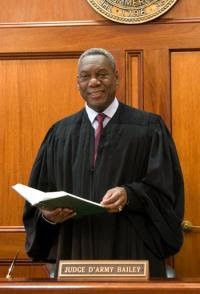
Judge D’Army Bailey
D’Army Bailey, a civil rights pioneer whose successful efforts to create the National Civil Rights Museum will long overshadow a personal career which itself had impressive successes and serious disappointments, died on Sunday at the age of 73 after a bout with cancer.
Bailey, who won election to a Circuit Court judgeship for the second time in his life just last year, had served previously on the Circuit court from 1990, when he first won election, to 2009 when he retired —temporarily as it turned out — to return to the practice of law as well as to attend to literary and acting careers.
It was in 2009 that Bailey published, with co-author Roger Easson, the second of his two books, The Education of a Black Radical: A Southern Civil Rights Activist’s Journey, 1959-1964. A previous volume, Mine Eyes Have Seen: Dr. Martin Luther King’s Final Journey, written with David Lyons, appeared in 1993.
Bailey also appeared as an actor in eight movies, ranging from the Memphis-filmed The People vs. Larry Flynt (1996), in which he portrayed a judge, to the romantic comedy How Stella Got Her Groove Back (1998).
Through all of the phases of his career, Bailey was an active public presence, and he appeared as recently as this past April on a blue-ribbon panel at a Black Law Students Association forum at the University of Memphis Law School to discuss the tumultuous period of the 1968 sanitation workers’ strike in Memphis and the assassination here of Dr. Martin Luther King.
But it was the creation of the NCRM which was Bailey’s supreme achievement. Though he was assisted at various points by others, both in and out of government, it was Bailey who had the vision and put together the plans and the financing that converted the Lorraine Motel, the assassination site of Dr. King, into the world-renowned museum that it is today.
Bailey himself was not only the founder but the first president of the NCRM, but, ever the controversialist, he found himself in something of a power struggle and was forced out of his leadership role at the Museum within little more than a year after its gala opening in 1991.
Bailey’s penchant for inviting controversy had also been demonstrated several years earlier when, as a resident of San Francisco after graduation from Yale Law School, he served a term on the Berkeley City Council from 1971 to 1973, when he was forced out of office in a recall election.
In 1974, Bailey returned to home-town Memphis, where he had graduated from Booker T. Washington High School, before getting a bachelor’s degree from Clark University in Worcester, Massachusetts.
In Memphis, Bailey would practice law with his brother, Walter Bailey Jr., who would become one of the longest-serving members of the Shelby County Commission and who was equally activist-minded. Through the years, as their careers permitted it, the two Bailey brothers were in the vanguard of breaking down barriers to black participation in a series of both public and private institutions which had previously excluded them.
During the governorship of Phil Bredesen, D’Army Bailey was listed as a favored choice on two separate lists presented to the governor by a state nominating panel to fill a vacancy on the Tennessee Supreme Court but was not chosen by Bredesen.
Among the first of many tributes that will undoubtedly be made to Bailey’s memory was this one from Shelby County Mayor Mark Luttrell: “Judge Bailey was a dedicated public servant. He served with fairness and professionalism in the judicial arena. Moreover, his guidance and expertise on civil rights and other community initiatives led to greater opportunities for the citizens of Shelby County. All of us at Shelby County Government extend our sympathy to his family.”
Judge Bailey is survived by his wife Adrienne, sons Justin Bailey and Merritt Bailey, his brother Walter, and his sister, Elsie Lewis Bailey.